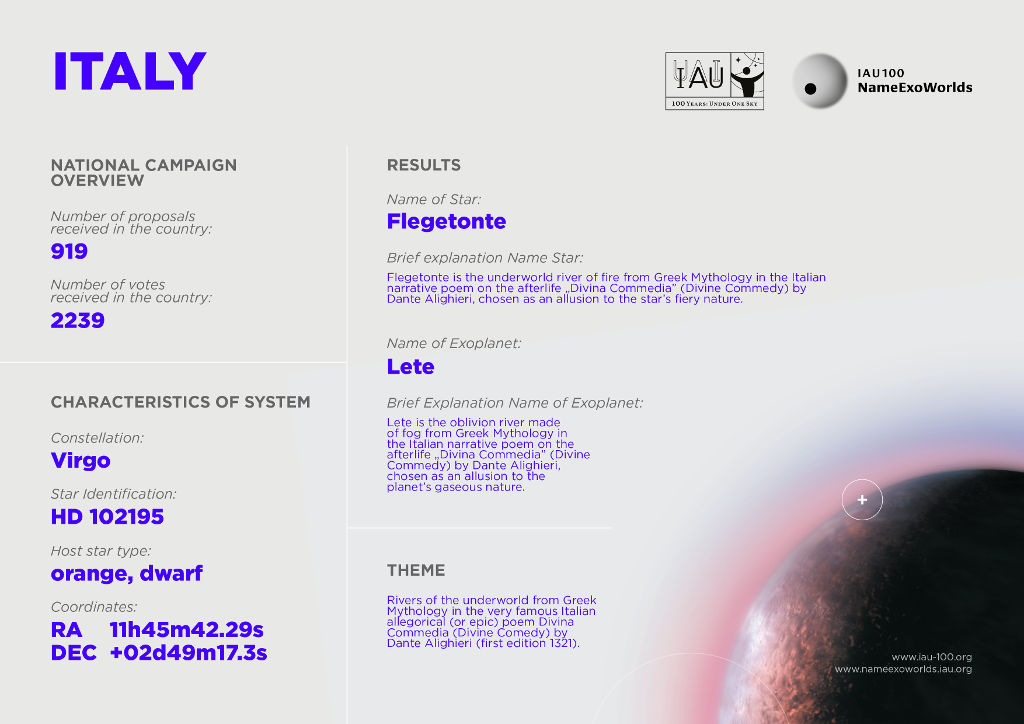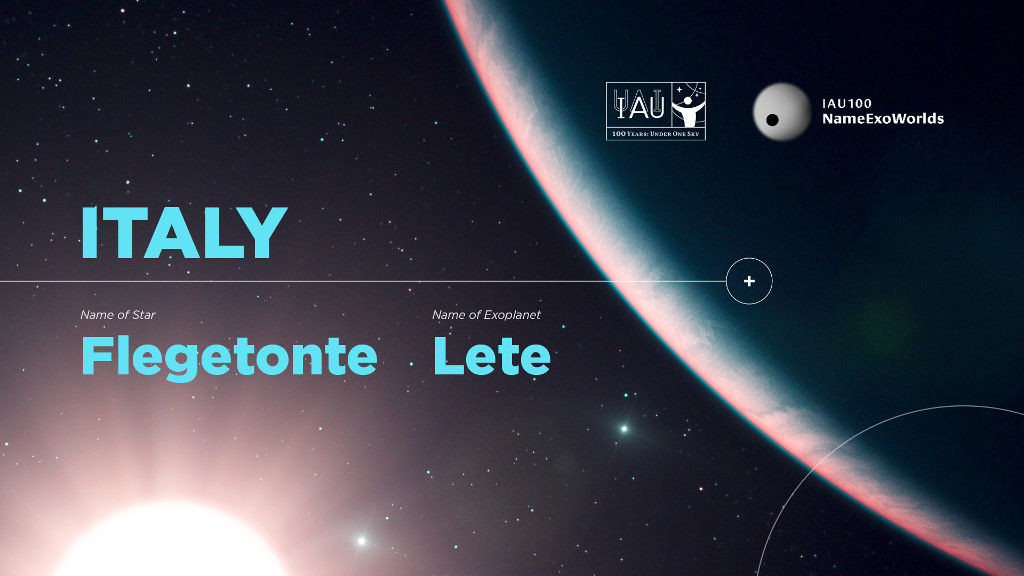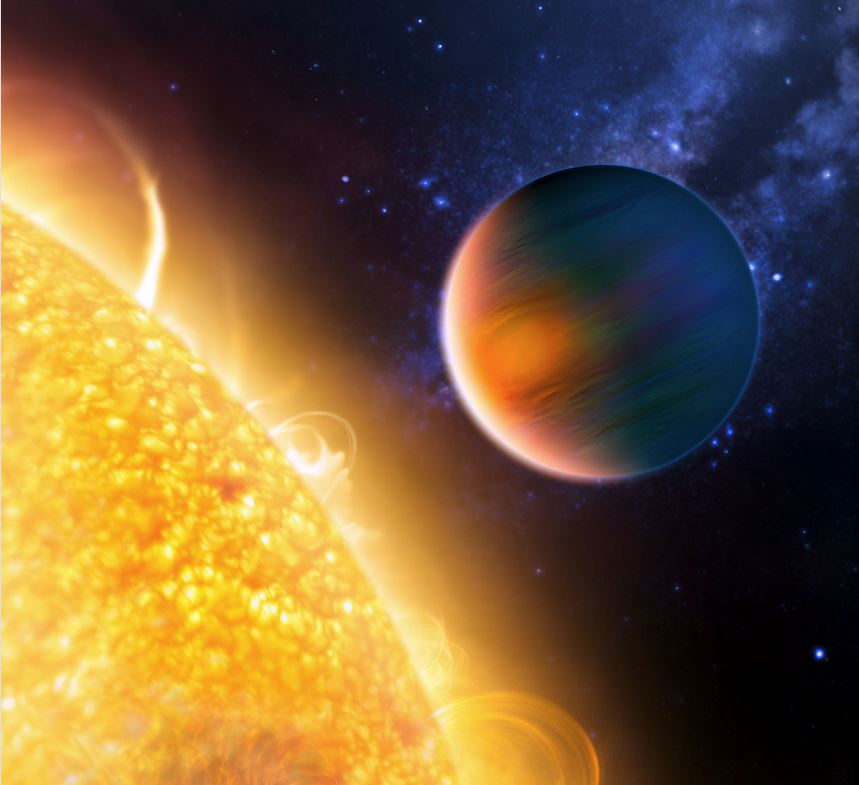Exoworlds: the final name for HD 102195

|

|
On 17 December 2019 the names of 112 sets of exoplanets and host stars named in the International Astronomical Union's NameExoWorlds campaigns were announced at a press conference in Paris. Within the framework of the International Astronomical Union's 100th anniversary (IAU100) commemorations, 112 countries organized national campaigns involving more than 780 000 people around the world, who proposed and selected the names for each exoplanet and its host stars.
The planetary system assigned to Italy is HD 102195 consisting of a giant planet and its star. After having carefully examined over 600 proposals, the commission selected three couples of names, Flegetonte-Lete, Aureus-Denarius and Pulcinella-Arlecchino.
In less than a month, more than 2,000 votes were received and Flegetonte-Lete were selected as the official names for the two celestial objects belonging to the planetary system assigned to Italy.
"The two names refer to rivers and infernal divinities mentioned in Dante's Divina Commedia, poem" tells us the young author of the winning proposal, Elia Ceci, 18 years old, a student of the Liceo Scientifico of Cupramontana (Ancona). "Flegetonte, the name chosen for the star, is originally the name of a river of fire; Lete - the name chosen for the planet, is originally the river of oblivion to remember the gaseous composition of the planet." In fact, the planet Lete is a gaseous giant with a mass approximately equal to half of Jupiter's mass and is orbiting a star slightly smaller than our Sun in less than 4 days.
The planetary system located at a distance of about 95 light years from Earth, was discovered in 2006 using the radial velocity method. The planet and its atmosphere were studied in detail by Gloria Guilluy, a young PhD student of INAF - Osservatorio Astronomico di Torino. She analyzed data obtained with the high-resolution near-infrared spectrograph GIANO, a cutting-edge instrument of the exoplanet studies, installed at the Telescopio Nazionale Galileo
The winner of the competition, in addition to see the name of the system in a list of exoplanetary systems, has won a trip to Telescopio Nazionale Galileo where, under the guidance of the staff, will have the possibility to participate in an observational run.
The IAU100 NameExoWorlds project has seen great participation from the public all over the world, by proposing relevant creative and unique names to the system assigned to their country. This is the second time in history that a campaign has led to give stars and their planets their own names.
Overall, 360 000 proposals were received from the participating countries. The National Committee of each country reduced the proposals to a short list which was then presented to the public for the final vote. 420,000 people participated, voting for their favorite candidates.
This project will have a lasting impact as the names chosen will be used in parallel with the scientific ones and will give prestige to the person, group or institution that suggested them.
"Astronomical observations over the past generation have now discovered over 4000 planets orbiting other stars called exoplanets. The number of discoveries continues to double about every 2½ years, revealing remarkable new planet populations and putting our own Earth and Solar System in perspective. Statistically, most of the stars in the sky are likely to be orbited by their own planets. They are everywhere!" said Eric Mamajek, co-chair of the NameExoWorlds Steering Committee. "While astronomers catalogue their new discoveries using telephone-number-like designations, there has been growing interest amongst astronomers and the public alike in also assigning proper names, as is done for Solar System bodies," Mamajek continued.
The IAU100 NameExoWorlds global project was conceived to create awareness of our place in the Universe and to reflect on how the Earth would potentially be perceived by an extraterrestrial civilisation. As the IAU is the authority responsible for assigning official names to celestial bodies, the IAU100 celebrations in 2019 were used as a special occasion to offer every country the chance to name one planetary system, comprising of an exoplanet and its host star.
The selected exoplanets are likely to be large gas giants, and all were discovered via two discovery methods: i. the transit method, where planets are observed to pass in front of their host star and block a portion of the star's light; ii. the radial velocity method, where the analysis of the spectrum of the star shows the periodic shift of the spectral lines towards the blue and the red regions of the spectrum due to the motion of the star around the center of gravity of the system caused by the rotation of the planet around its host star.

Useful links:
https://www.iau.org/news/pressreleases/detail/iau1912/?lang
https://www.media.inaf.it/2019/12/17/lete-flegetonte-name-exoworlds/
More information: dydat@tng.iac.es

